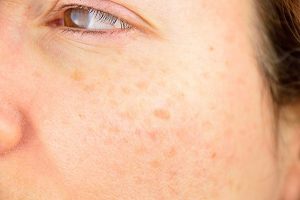Benign lesions are non-cancerous lesions that are not threatening to a patient’s health, but that people often want removed. Skin tags, sun spots and seborrheic keratosis are a few of the benign lesions commonly treated by the board-certified dermatologists at Dermatology Center of Acadiana.
Skin tags are named due to their resemblance to a tag. They are benign skin growths that are small and soft, and often hang slightly on a stalk. They are most common in middle age people but can happen to anyone. Most people will develop at least one skin tag at some point in their lives.
Most skin tags are small (less than 5 mm in diameter), but in rare cases, they can become much bigger.
 Sun spots or age spots that often occur after persistent unprotected sun exposure to an area of the body
Sun spots or age spots that often occur after persistent unprotected sun exposure to an area of the body
While these are some of the most common places for skin tags to develop, they can develop most anywhere on the body.
Skin tags are not contagious and are generally harmless, but many people prefer to get them removed for cosmetic reasons. Sometimes a skin tag will get irritated or act up from being in a place of high friction.
There are a number of different treatments that can be used for skin tags, and the treatment that is best for your situation will depend on the size, location and number of tags. Snipping, freezing, or burning off skin tags are all options and have different benefits and risks. Make sure to talk to your board certified dermatologist before taking action to make sure you are informed on what will get you the best results.
About 80% of the skin’s aging appearance is due to sun exposure. Age spots, brown spots or sun spots and uneven skin pigmentation are among the most common effects of sun damage. We will refer to them all as age spots for simplicity.
A daily skin care regimen that includes a good sunscreen can be a great way to stop age spots before they start. If you already have age spots, there are a variety of different options for treatment depending on the severity and location of your age spots.
Depending on the type, number and location of your age spots there are a number of different potential treatments.
Talk to your board certified dermatologist to figure out what the best option is for your unique situation and skin type.
Seborrheic keratosis are most common in middle aged or older patients. They may range in color from light tan to dark brown and have a wart like texture. They are often called the “barnacles of aging”. The head, neck, chest and back are the most common areas to find them.
Many people find seborrheic keratoses alarming because they can appear similar to a wart, actinic keratosis or skin cancer. A seborrheic keratosis is harmless, but if you are not sure if that is what you have then it is best to get it looked at by a dermatologist. Early detection is the single most important part for effective treatment of skin cancer, regardless of what type of skin cancer.
While seborrheic keratoses are harmless, it is not uncommon for patients to want them removed for cosmetic reasons or for peace of mind. If it is in an area where it tends to get in the way of clothing, patients may want the lesion removed for comfort.
If the seborrheic keratosis resembles skin cancer, it may be shaved off and examined under a microscope to confirm it is benign.
Freezing with cryosurgery: After freezing with liquid nitrogen, the keratosis falls off within a few days.
Electrosurgery and/or curettage: An electric current can be used to destroy the keratosis and a curette is used to scoop off the growth afterwards. Sometimes only one of these two options is necessary.
Other Benign Tumors and Lesions: There are a wide variety of benign tumors, these are just some of the most common ones.
If you have questions or concerns about any growths or irregularities on your skin make sure to schedule an appointment with your dermatologist today.
